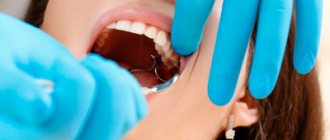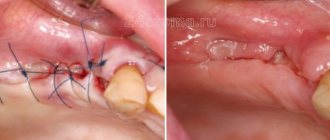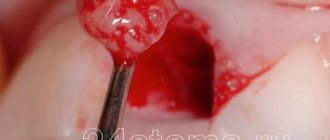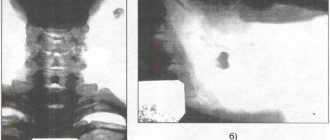Prerequisites for appointment
After tooth extraction, antibacterial drugs are not prescribed to all patients - only for serious indications. Amoxiclav after tooth extraction is often recommended for patients who have developed an acute purulent inflammatory process.
The prescribed therapy will help prevent the development of complications and stop further infection of tissues in the oral cavity. After surgical interventions, medication is prescribed without fail to prevent the development of an infectious process on the open wound surface.
For planned simple removal procedures, Amoxiclav is used when foci of caries are detected - as a means of preparation for the upcoming procedure. The main condition for this type of prevention is the absence of suppuration and inflammation.
Incorrectly grown teeth provoke a future inflammatory process in the gum tissue, which manipulation can lead to infection of the socket. The pharmacological agent is administered to the patient immediately before the medical procedure and after its completion.
The prescription of Amoxiclav in the postoperative period requires the presence of predisposing factors:
- prophylaxis to prevent the development of an abscess;
- complete suppression of the activity of pathogenic microorganisms;
- creating measures to prevent suppuration of the hole - after an extracted molar;
- protection of bone tissue health;
- a sharp drop in the functionality of the autoimmune system;
- traumatization of nearby tissues after extraction of a problematic tooth;
- inflammatory processes near the problem area;
- pathological abnormalities in the level of blood clotting;
- the appearance of a large hole.
Negative symptomatic manifestations provoke the formation of:
- sudden bursts of severe painful sensations;
- loss of appetite;
- a real threat of blood poisoning - up to the development of septic conditions.
Amoxiclav has valuable quality - its use is allowed at any age.
Pain
An absolutely normal symptom after removal surgery is pain, often severe, which intensifies a couple of hours after the operation, when the anesthesia wears off. The pain may last for several days, but gradually weakens every day.
For pain relief, dentists prescribe non-steroidal anti-inflammatory drugs, for example, Ketanov or Meloxicam. These are modern means. If for some reason they are not available to the patient, simpler painkillers can be used. But it quite happens that they do without analgesics. For example, people with a high pain threshold do not need pain relief. You should also not overuse painkillers, because this can mask possible complications of the postoperative period. If you see that you have to increase the dose of your painkiller after three days, this is a mandatory reason to see a doctor.
There are also cases when, in the postoperative period, in order to improve blood clotting, hemostatic drugs (drugs that help stop bleeding) are prescribed: “Ascorutin”, “Transcam”, “Ditsinon”, “Vikasol”, etc. These prescriptions are made when the patient has low blood clotting or bleeding.
But in general, antibiotics are always prescribed after tooth extraction.
Dosage
The selection of the required amount of the drug is carried out on an individual basis and depends on the number of complications after the manipulation to remove problem teeth. The dentist prescribes the medication in optimal dosages to prevent the occurrence of negative reactions from the body and symptoms of overdose.
After complex surgical interventions involving large surgical fields, Amoxiclav 625 mg is prescribed for preventive purposes, one unit of the substance, up to two times a day. The drug is used after meals for five days.
With the development of an acute inflammatory process, the drug is recommended for use up to three times a day. The drug is used in the treatment of children of all ages:
- up to 10 years - in the form of suspensions;
- from 10 to 16 years - tablet form "Amoxiclav 375".
Individual dosage is calculated according to the child’s body weight, and not according to individual age groups.
Use during gestation and feeding
Any antibacterial agent affects the growth and development of the fetus - therefore, an antibiotic is prescribed during pregnancy if absolutely necessary, according to the decision of the attending dentist.
Changes in hormonal levels during pregnancy do not allow you to calculate the required dosage. Specialists use the drug in minimal quantities and in conditions where a woman’s health is at risk.
After removal of problematic molars, for women during lactation, dentists recommend the use of Amoxiclav in minimal doses, up to three times a day. If the mother has contraindications to the use of this substance, it is replaced with similar medications.
The course of the postoperative recovery period
Let's consider the main characteristics of the postoperative period:
- The appearance of swelling at the site of an extracted tooth is normal. This is especially common after the removal of a number eight (wisdom tooth).
- There may be a bluish swelling at the removal site, which is also normal. This is usually characteristic of patients suffering from high blood pressure.
- On the first day after surgery, you may also experience high body temperature and deterioration in health.
There is no need to be afraid of all of the above. Normally, these unpleasant symptoms decrease every day.
Is it really necessary to take antibiotics after tooth extraction?
Prohibitions on use
The main range of contraindications for dental therapy includes a number of conditions:
- spontaneous allergic reactions to a subgroup of penicillins and their analogues - the condition is an absolute prohibition, in which a more suitable remedy is selected;
- with insufficient functionality of the liver and kidneys or disturbances in their performance;
- in case of lymphocytic leukemia – neoplasms in the area of red bone marrow (lymphatic sprout);
- for certain types of viral lesions - infectious mononucleosis.
Any non-standard reactions of the body of allergic etiology when using a medicinal product are the basis for a ban on use.
Solutions used for mouth rinsing
The pharmaceutical market offers a sufficient range of ready-made rinsing solutions. These are solutions based on chlorhexidine, as well as the well-known “Furacilin”. You can also prepare a soda or saline solution at home (1 teaspoon per glass of water). The concentration cannot be increased, because this can cause a chemical burn to the oral cavity. Herbal decoctions are also perfect - chamomile, sage, oak bark and others. They also provide an excellent restorative and anti-inflammatory effect. So, let's consider which antibiotics to purchase after tooth extraction.
Negative reactions
When using the medicine, the body may experience adverse reactions:
Hematopoiesis department:
- anemic conditions;
- eosinophilia – increased number of eosinophils in laboratory parameters;
- thrombocytopenia – decreased platelet count;
- agranulocytosis – decrease in leukocyte counts;
- leukopenia - a decrease in leukocytes in the blood count.
Digestive department:
- increased gas formation;
- gastroduodenitis;
- dyspeptic disorders – diarrhea;
- nausea leading to vomiting;
- glossitis - inflammation of the tissues of the tongue;
- stomatitis;
- anorexia;
- enterocolitis is a simultaneous inflammatory process in the small and large intestines.
Nervous system:
- unreasonable anxiety;
- non-standard behavior;
- increased arousal;
- convulsive conditions;
- impaired clarity of consciousness;
- hyperactivity;
- periodic dizziness;
- sudden attacks of headache.
Skin:
- swelling;
- rashes on the dermis;
- hives;
- exfoliative dermatitis;
- epidermal necrolysis of toxic origin;
- erythema multiforme;
- acute toxic-allergic lesions - Stevens-Johnson syndrome.
Urinary department:
- hematuria;
- interstitial nephritis.
In some cases, superinfection may occur, including candidiasis. Negative reactions of the body due to the use of the drug are mild and temporary.
Overdose
Accidental or intentional excess of the recommended volumes of the drug cannot cause death or serious life-threatening side effects.
The main symptomatic manifestations of overdose are:
- changes in water and electrolyte balance indicators;
- disturbances in the functioning of the gastrointestinal tract - pain in the epigastric region, diarrhea and vomiting;
- development of crystalluria with a gradual transition to insufficient renal functionality;
- convulsive phenomena suggest the use of a pharmacological agent in increased dosages or in cases of impaired renal function.
An overdose requires contacting a medical facility for symptomatic drug therapy. If the drug was used less than four hours ago, the patient is prescribed gastric lavage and activated charcoal. In more serious cases, cleansing the body is carried out by hemodialysis.
Protected penicillins
They are the most widely represented and widely used group of antibiotics prescribed by dentists. Here are examples of drugs included here:
- "Flemoxin".
- "Flemoclav".
- "Amoxicillin."
- "Amoxiclav".
What antibiotics should I take after wisdom tooth removal?
There are many analogues and trade names of these antibiotics.
These are all antibiotics with a wide spectrum of activity. They are effective against both gram-positive and gram-negative bacteria.
If there is a threat of generalization of infection in the body, antibiotics are prescribed intramuscularly or intravenously. In more common cases, oral antibiotics are indicated.
The course of treatment is determined by the doctor taking into account the patient’s age, weight and the presence of complications after surgery or based on test results, if any. The tolerability of the drug is also taken into account. Accepted within five to seven days.
What other antibiotics are prescribed after wisdom tooth removal?
Aminoglycosides
These are drugs based on gentamicin and amikacin. They are used for intravenous and intramuscular injections. This group of drugs is prescribed when the postoperative wound is already infected in order to prevent infection from entering the circulatory system. They have a wide spectrum of action.
It is important to note that this group of drugs has strict contraindications during pregnancy and lactation, as well as for children.
Fluoroquinolones
Fluoroquinolones based on the active substance digitran are used in dentistry. They are prescribed if an infected complication or a threat of infection of a postoperative wound is detected. They are available both in tablet form and in the form of injection solutions. The course of treatment is usually 7 days. In case of a complicated course, the course of treatment is extended to 14 days.
You can take other antibiotics after tooth extraction.
Lincosamides
In dentistry, Lincomycin is often used, which also has a wide range of antibacterial activity. The course of treatment with the drug usually ranges from 7 to 14 days. "Lincomycin" is not prescribed to pregnant women, persons with severe liver disease, or women during breastfeeding.
Like all drugs, antibiotics have a number of side effects. It is worth noting the following:
- allergic reactions;
- individual intolerance to the active substance of the drug;
- adverse reactions from the stomach and intestines: nausea, vomiting, diarrhea;
- headache;
- dizziness;
- cardiopalmus;
- disorders of the liver and kidneys;
To avoid side effects, a test dose of the drug is prescribed. It is also recommended to take an antibiotic along with antihistamines at least on the first day. This is done in order to reduce the severity of a possible reaction.
Not everyone knows what antibiotics to take after tooth extraction.
Features of use
The use of medication for dental therapy is carried out after the appointment of the attending physician. The patient must read the instructions provided, paying attention to the following special instructions:
- Before first use, you must make sure that there are no allergic reactions to the components included in the drug. It is advisable to conduct a preliminary allergy test.
- The product is used in the formation of a bacterial type of infectious process caused by pathogenic microflora that is sensitive to the active ingredient. Amoxiclav has no effect on viral infections. Before therapy, it is necessary to carry out bacteriological culture to determine the type of pathogen and its resistance to the drug.
- If there is a lack of the required effectiveness of the drug within two days, then the drug is replaced with a similar substance or a change in treatment tactics is necessary.
- The medication is prescribed with extreme caution to persons with impaired renal or liver function, and at the same time, constant monitoring of their performance is carried out.
All recommended features must be taken into account when drawing up the necessary therapy regimen.
Requirements for the use of antibiotics
Antibacterial drugs should be used in strict accordance with the dentist's prescriptions. Medicines lose their effectiveness with the following deviations:
- with independent dosage changes;
- missing time to take medications;
- spontaneous change in the entire treatment regimen.
Specialists require all patients to know the rules for taking Amoxiclav.
Duration of use
No change in accuracy and time of application - the recommended intermediate time must be maintained between two applications. Precise timing of use will allow you to maintain the concentration of the active component at the proper level:
- in the case of a three-time daily appointment, the interval is at least eight hours;
- with a double dose, treatment is carried out every 12 hours.
Antibiotics should be taken at the same hours, regardless of the form of manufacture.
Duration of therapeutic effect - the average duration of treatment is one calendar week; if necessary, the process can be extended to two weeks. The treating specialist is responsible for adjusting the timing of the appointment.
Changing dosage
Prohibition on independent changes in dosage - individual patients reduce the prescribed volume of medication spontaneously. The main goal of the change is to take care of your own health. In reality, these actions can lead to the ineffectiveness of the drug and the emergence of microflora resistance to the active ingredient.
An unauthorized increase in dosage often provokes the formation of overdoses and the development of severe side effects.
Discontinuation
Discontinuation of treatment – it is prohibited to stop prescribed therapy in the middle of the process. Some patients, feeling better, believe that the treatment can be considered complete. Experts recommend continuing therapy for another three days from the moment your health returns to its previous limits.
Dentists ask patients to report the lack of effectiveness of the treatment if no visible improvements occur within three days. Low efficiency indicates resistance of pathogenic microflora and the need to replace the drug.
Admission rules
Rules for administration - the instructions supplied with the medication clearly state the requirement for use - before, during or after eating. Doctors advise patients to drink the pharmacological drug with clean drinking water, without gases.
Using any other drinks may render the medicine ineffective or reduce its effectiveness. It is forbidden to take medications with juices, coffee, tea, fermented milk and dairy products (unless specifically stated in the instructions).
Diet food
Dietary nutrition - all antibacterial agents are a serious burden for the patient’s body. Their main active components can have a depressing effect on the functionality of the digestive tract. Experts advise following the required diet during the treatment period.
When using Amoxiclav, you need to exclude from the daily menu:
- fried;
- fat;
- canned food;
- sour fruits;
- alcoholic and low-alcohol drinks.
You need to include in your diet:
- fresh vegetables;
- sweet fruits;
- clean drinking water.
On the nuances of diet, the dentist will provide comprehensive information suitable for each individual case.
Treatment of the intestinal tract
Additional treatment of the intestinal tract - antibiotic therapy involuntarily leads to suppression of the activity of standard intestinal microflora. Changes in the digestive tract can provoke the development of the following symptomatic abnormalities:
- bloating;
- constant heartburn;
- dyspeptic disorders - constipation and diarrhea;
- painful sensations in the gastrointestinal tract.
To prevent further death of microflora and return it to its original values, doctors recommend taking special medications and fermented milk products. Therapy is carried out during breaks between courses of antibiotic treatment.
Ignoring supportive treatment can provoke the development of pathologies of the stomach and intestines.
Important nuances - at the time of prescribing any type of antibacterial medication, the patient must pay attention and take it seriously:
- use in other pathological processes;
- prohibitions on use;
- negative responses of the body;
- permission for use with age restrictions.
Without prior consultation with a dentist, antibiotic therapy is strictly prohibited for a certain category of people:
- when the body is weakened;
- in childhood;
- during pregnancy and breastfeeding.
Advice for patients
In addition to all of the above, there are general recommendations from dentists during the postoperative period:
- You should refrain from eating for at least 2-3 hours after surgery. This is the time during which the blood in the wound finally coagulates and the result of the hemostasis system is consolidated.
- It is advisable to eat soft food for 3 days to avoid injury to the socket of the extracted tooth. It is also advisable to avoid eating too cold or hot food.
- Alcohol consumption is contraindicated, as it leads to a decrease in local immunity and causes vasodilation, which in turn contributes to the development of postoperative complications.
- Any procedures that lead to vasodilation are contraindicated, as they may cause bleeding. You should avoid baths, saunas, and prolonged exposure to the sun.
- It is forbidden to pick at a postoperative wound. This is a direct and sure path to infection with consequences in the form of a severe inflammatory process.
We looked at what antibiotics to take after tooth extraction.
Category: Tooth extraction Published by Mister stomatolog
Possible interaction
Simultaneous use of Amoxiclav with other bactericidal antibiotics increases the effectiveness of the main drug.
A decrease in the desired result is observed when using an antibiotic with certain medications:
- macrolides;
- tetracyclines;
- sulfonamides.
Sharing the medicine with hormonal contraceptives weakens the functionality of the latter.
When using the drug and alcoholic (low-alcohol) drinks, a decrease in the effectiveness of the drug and a possible negative effect on the liver are observed.
Combined treatment with anticoagulants can increase prothrombin time - if necessary, extreme caution should be used.
Specifics of flux therapy
Self-exposure to the affected area with antibiotics does not make logical sense - in one case out of a hundred, the patient correctly guesses the required drug. When visiting a medical facility, the patient undergoes a full diagnostic examination, which allows one to determine the type of pathogen that has penetrated and its level of resistance to medications.
During the examination, the dentist will accurately determine the problem tooth that caused the formation of the inflammatory process, the need for sanitation of the oral cavity (treatment of carious surfaces) and only after all the procedures will he prescribe a treatment regimen.
Purulent lesions that form near the apex of the tooth root are most often caused by staphylococcal or streptococcal infections. Even without carrying out the necessary diagnostics, experienced specialists will recommend that the patient adhere to the following rules:
- the total time of therapeutic effect cannot exceed two weeks, a smaller number of days is determined by the severity of the pathological process;
- flux detected in the initial stages can be treated conservatively with medications;
- pathology recorded in advanced stages requires surgical intervention.
The presence of constant toothache indicates the development of pathological abnormalities that cannot be cured on your own. In any scenario, a visit to a dentist will take place. Experts recommend avoiding self-medication with the “best” antibiotics recommended by neighbors and work colleagues.
The drug Amoxiclav is one of the most commonly used drugs in the practical work of surgical dentists. The positive quality of the medication is its tolerability and the minimum number of adverse reactions of the body.
Use during pregnancy and lactation is not prohibited by the manufacturer; there is only a limitation on permissible dosages. If the requirements of the instructions attached to the pharmacological substance and the advice of the attending physician are correctly followed, the drug will act in a short time. The high effectiveness of the drug allows it to be considered one of the main drugs for the treatment of inflammatory and other pathological processes in the oral cavity.
Sources used:
- Medicines in dentistry. Directory / L.N. Maksimovskaya, P.I. Roshchina. — M.: Medicine
- Rational pharmacotherapy in dentistry. — M.: Litterra
- National Library of Medicine (USA)
- The use of non-steroidal anti-inflammatory drugs for the treatment of dental diseases / S.T. Sokhov et al. - M.: MEDpress-inform, 2011.
When it's justified
The practice of prescribing antibiotics precisely after the removal of the figure eight is very common. However, not all patients need this. We list the most common cases of their purpose:
- the tooth was removed promptly, as a result of acute and severe inflammation, i.e. unscheduled;
- During removal, the gum or tooth socket was damaged;
- removal or postoperative period is accompanied by severe bleeding;
- with severe inflammation on the adjacent gums;
- a difficult operation to perform;
- reduced immunity or various chronic diseases in the patient, which slow down the recovery process;
- elderly patients.
Patients often ask whether to take antibiotics after tooth extraction.
These drugs are not always prescribed immediately. They may be prescribed later if the following symptoms are detected:
- strong pain;
- severe redness, swelling of tissue at the site of removal;
- suppuration or necrotization of tissue in the hole;
- no protective blood clot is detected in the socket;
- hyperthermia.
Antibiotics are quite often prescribed after the removal of a wisdom tooth, especially if it was impacted (partially erupted and hidden in the gum) or dystopic (had an incorrect position in the jaw). Such removal operations very often carry a potential risk of developing infectious complications. In addition, antibiotics are prescribed if the extracted tooth contained a purulent cyst.
In addition to antimicrobial agents, non-steroidal anti-inflammatory drugs are often prescribed in the postoperative period to relieve inflammation, as well as rinsing with antiseptic solutions.
Whether antibiotics are needed after tooth extraction should be checked with your doctor.
Many patients unfairly ignore rinsing recommendations. But in vain. It aims to create a wound-healing effect, as well as provide an anti-inflammatory effect. This also needs to be done correctly. Do not rinse too vigorously, as this will only cause the wound to bleed. In addition, such increased movements of the solution in the mouth can cause the penetration of opportunistic oral flora into the tooth socket, thereby causing an inflammatory process. You can simply put the solution in your mouth and hold it for 10-15 minutes. This rinsing procedure can then be repeated.
So antibiotics after tooth extraction are not needed in every case.










